高中英语时态讲解
- 格式:pptx
- 大小:39.93 MB
- 文档页数:41
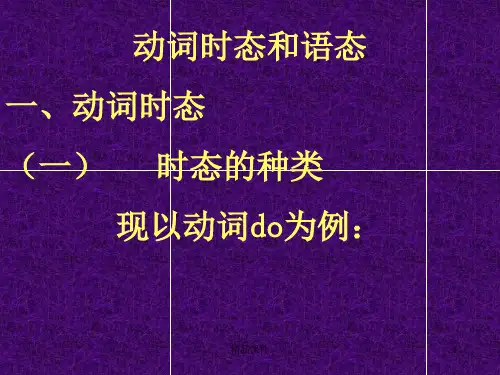
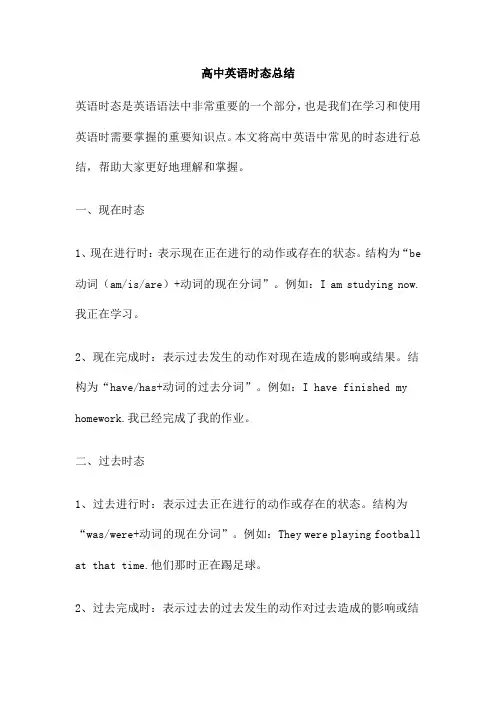
高中英语时态总结英语时态是英语语法中非常重要的一个部分,也是我们在学习和使用英语时需要掌握的重要知识点。
本文将高中英语中常见的时态进行总结,帮助大家更好地理解和掌握。
一、现在时态1、现在进行时:表示现在正在进行的动作或存在的状态。
结构为“be 动词(am/is/are)+动词的现在分词”。
例如:I am studying now.我正在学习。
2、现在完成时:表示过去发生的动作对现在造成的影响或结果。
结构为“have/has+动词的过去分词”。
例如:I have finished my homework.我已经完成了我的作业。
二、过去时态1、过去进行时:表示过去正在进行的动作或存在的状态。
结构为“was/were+动词的现在分词”。
例如:They were playing football at that time.他们那时正在踢足球。
2、过去完成时:表示过去的过去发生的动作对过去造成的影响或结果。
结构为“had+动词的过去分词”。
例如:They had finished their work before we arrived.他们在我们到达之前已经完成了他们的工作。
三、将来时态1、将来进行时:表示将来某个时间正在进行的动作或存在的状态。
结构为“will+be动词+动词的现在分词”。
例如:I will be studying at 9 o’clock tomorrow.我明天9点将会在学习。
2、将来完成时:表示将来某个时间已经完成的动作或达到的状态。
结构为“will+have+动词的过去分词”。
例如:I will have finished my homework by 10 o’clock tonight.我将在今晚10点之前完成我的作业。
以上是高中英语中常见的时态总结,希望能够帮助大家更好地理解和掌握英语时态。
需要注意的是,不同的时态有着不同的用法和结构,大家在使用时需要根据语境选择合适的时态。
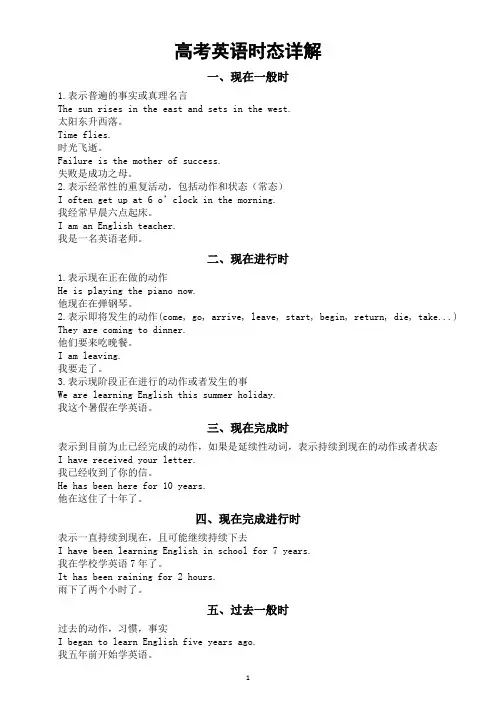
高考英语时态详解一、现在一般时1.表示普遍的事实或真理名言The sun rises in the east and sets in the west.太阳东升西落。
Time flies.时光飞逝。
Failure is the mother of success.失败是成功之母。
2.表示经常性的重复活动,包括动作和状态(常态)I often get up at 6 o’clock in the morning.我经常早晨六点起床。
I am an English teacher.我是一名英语老师。
二、现在进行时1.表示现在正在做的动作He is playing the piano now.他现在在弹钢琴。
2.表示即将发生的动作(come, go, arrive, leave, start, begin, return, die, take...) They are coming to dinner.他们要来吃晚餐。
I am leaving.我要走了。
3.表示现阶段正在进行的动作或者发生的事We are learning English this summer holiday.我这个暑假在学英语。
三、现在完成时表示到目前为止已经完成的动作,如果是延续性动词,表示持续到现在的动作或者状态I have received your letter.我已经收到了你的信。
He has been here for 10 years.他在这住了十年了。
四、现在完成进行时表示一直持续到现在,且可能继续持续下去I have been learning English in school for 7 years.我在学校学英语7年了。
It has been raining for 2 hours.雨下了两个小时了。
五、过去一般时过去的动作,习惯,事实I began to learn English five years ago.我五年前开始学英语。
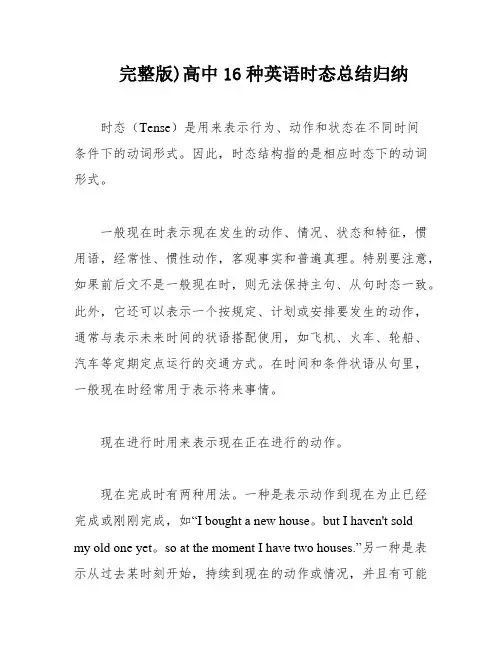
完整版)高中16种英语时态总结归纳时态(Tense)是用来表示行为、动作和状态在不同时间条件下的动词形式。
因此,时态结构指的是相应时态下的动词形式。
一般现在时表示现在发生的动作、情况、状态和特征,惯用语,经常性、惯性动作,客观事实和普遍真理。
特别要注意,如果前后文不是一般现在时,则无法保持主句、从句时态一致。
此外,它还可以表示一个按规定、计划或安排要发生的动作,通常与表示未来时间的状语搭配使用,如飞机、火车、轮船、汽车等定期定点运行的交通方式。
在时间和条件状语从句里,一般现在时经常用于表示将来事情。
现在进行时用来表示现在正在进行的动作。
现在完成时有两种用法。
一种是表示动作到现在为止已经完成或刚刚完成,如“I bought a new house。
but I haven't soldmy old one yet。
so at the moment I have two houses.”另一种是表示从过去某时刻开始,持续到现在的动作或情况,并且有可能会继续延续下去。
这时通常使用延续性动词,时间状语常用since加一个过去的时间点,或for加一段时间,或by加一个现在时间。
4.现在完成进行时 (have been doing)现在完成进行时用来描述一个从过去某一时间开始一直持续到现在的动作或状态,或将继续持续到未来。
例如:我们已经处理这个项目一个多月了,一直在进行中。
5.一般过去时一般过去时用来描述过去某个时间发生的动作或情况,或者过去的惯性动作。
例如:这位老人过去常常坐在公园的长椅上看着别人,一坐就是数个小时。
他以前总是每周看望他的母亲。
在句型中使用 "no sooner than"、"___"、"before"、"r to" 等连接词时,主句要求完成时。
例如:今天之前我从未见过那位教授。
在填空题中,句子中的动作已经持续了一段时间,并且需要进行修理。
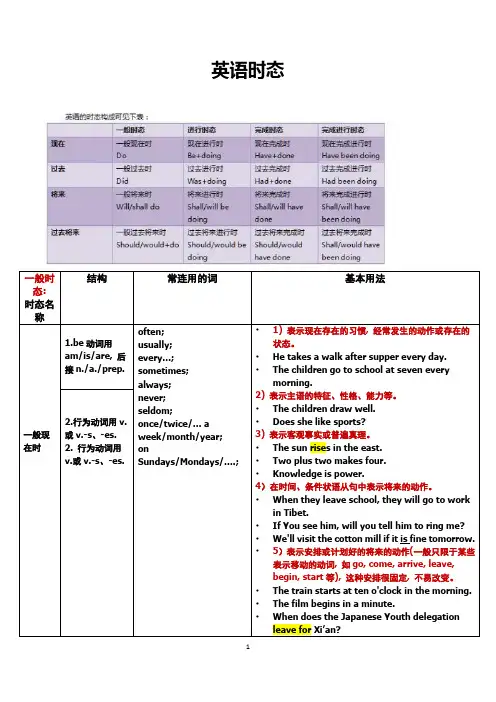
英语时态一般时态:时态名称结构常连用的词基本用法一般现在时1.be动词用am/is/are, 后接n./a./prep.often;usually;every…;sometimes;always;never;seldom;once/twice/… aweek/month/year;onSundays/Mondays/….;•1) 表示现在存在的习惯, 经常发生的动作或存在的状态。
•He takes a walk after supper every day.•The children go to school at seven everymorning.2)表示主语的特征、性格、能力等。
•The children draw well.•Does she like sports?3) 表示客观事实或普遍真理。
•The sun rises in the east.•Two plus two makes four.•Knowledge is power.4)在时间、条件状语从句中表示将来的动作。
•When they leave school, they will go to workin Tibet.•If You see him, will you tell him to ring me?•We'll visit the cotton mill if it is fine tomorrow.•5)表示安排或计划好的将来的动作(一般只限于某些表示移动的动词, 如go, come, arrive, leave,begin, start等), 这种安排很固定, 不易改变。
•The train starts at ten o'clock in the morning.•The film begins in a minute.•When does the Japanese Youth delegationleave for Xi’an?2.行为动词用v.或v.-s、-es.2. 行为动词用v.或v.-s、-es.1.________ a concert next Saturday?2. A.There will be B.Will there be C.There can be D.There are3.It’s good t o see you again, Agnes.— This has been our first chance to visit since from Iran.4. A.you return B.you returned C.you have returned D.returning5.If it ________ tomorrow, we’ll go roller-skating.A.isn’t rainB.won’t rainC.doesn’t rainD.doesn’t fine4.The reporter said that the UFO ___ east to west when he saw it.A.was travelingB.traveledC.had been travelingD.was to travel5.Sorry, I can’t open the door, for I the key to it.A.lostB.loseC.had lostD.have lost6.“What ' s the matter, Ali? You look sad.”“Oh, nothing much.As a matter of fact, I ___ of my friends back home.”A.just thoughtB.have just been thinkingC.was just thinkingD.have just thought7.—Did you expect Frank to come to the party? —No, but I had hoped .A.him comingB.him to comeC.that he comesD.that he would come8.—Bob must be very wealthy.—Yes, he more in one day than I do in a week.A.has been earnedB.had earnedC.earnsD.has earned9.I first met Lisa three years ago.She ___ at a radio shop at the time.A.has workedB.was workingC.had been workingD.had worked10.She _____her keys in the office so she had to wait until her husband ____home.A has left; comesB had left; would comeC had left; cameD left; had come11.Zhao Lan ______already ______in this school for two years.12.A.was ; studying B.will ; study C.has ; studied D.are ; studying---Mr Gorden asked me to remind you of the meeting this afternoon .Don’t forget it !---OK.I ______ .13.A.won't B.don't C.will D.do14.When I reached home, my parents __________their supper.15.A.are having B.have already had C.have had D.had already had16.She __________in this school ________the past ten years.A.was teaching, sinceB.had been teaching, since17.C.would teach, for D.has been teaching, forI first met Tom 10 years ago.He ______ in a radio factory at that time.18.A.had worked B.has worked C.was working D.has been working19.--- What ______ when I phoned you?--- I ______ my work, and I wanted to go out.A.have you done; finishedB.were you doing; have finished20.C.did you do; had just finished D.were you doing; had just finished21.I used to drink a lot of tea but these days I ______ coffee.22.A.prefer B.preferred C.had preferred D.am preferringJim talked for about half an hour yesterday.Never ______ him talk so much.23.A.I heard B.did I hear C.I had heard D.had I heard24.He ___ articles for our wall-newspaper these three years, and he ____ about fortyarticles.A.has been writing; has writtenB.had been writing; wrote25.C.is writing; has been writing D.has written; has written26.When he was alive, the old scientist used to say that knowledge ______ from practice andhe gained his experience by doing a lot of practical work.27.A.was coming B.had come es D.would come28.--- How are you planning to travel to Shanghai?--- I ______ yet, but I ______ taking a train.A.didn’t decide; am consideringB.haven’t decided; consider29.C.haven’t decided; am considering D.hadn’t decided; have considered30.--- Who’s the man over there?--- It’s Jack.--- Oh? ______ in Italy.A.I think he’sB.I’ve thought he’s been31.C.I thought he was D.I’d thought he’d beenI thought Jim would say something about his school report, but he ______ it.32.A.doesn’t mention B.hadn’t mentioned C.didn’t mention D.hasn’t mentioned33.—How long ________ each other before they ________ married?—For about a year.A.have they known; getB.did they know; getC.do they know; are going to getD.had they known; gotWe would like to go and thank him ourselves, but we ________ out his address yet,A.haven’t foundB.hadn’t foundC.didn’t findD.don’t find34.Shirley ________ a book about China last year but I don’t know whether she has finished.A.has writtenB.wroteC.had writtenD.was writing35.—Do you know when Tom ________ from abroad?—Perhaps it will be a long time before he ________ back.A.will come; will comees; will comeC.will come; comeses; comesThe pen I ________ I ________ is on my desk, right under my nose.A.think; lostB.thought; had lostC.think; had lostD.thought; lostHowever hard you ________, you will never succeed in pleasing her.A.tryB.will tryC.should tryD.would try36.By this time tomorrow we ________ the machine.A.have repairedB.shall have repairedC.will repairD.would repair37.I ________ the room to be empty but found it occupied.A.had thoughtB.have thoughtC.didn’t thinkD.was thinking。

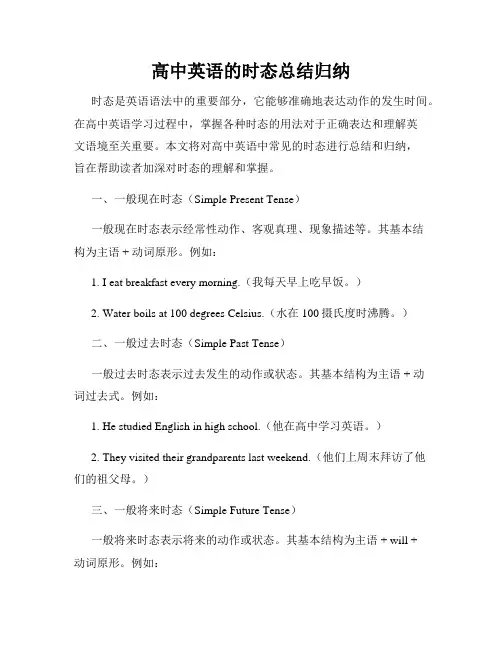
高中英语的时态总结归纳时态是英语语法中的重要部分,它能够准确地表达动作的发生时间。
在高中英语学习过程中,掌握各种时态的用法对于正确表达和理解英文语境至关重要。
本文将对高中英语中常见的时态进行总结和归纳,旨在帮助读者加深对时态的理解和掌握。
一、一般现在时态(Simple Present Tense)一般现在时态表示经常性动作、客观真理、现象描述等。
其基本结构为主语 + 动词原形。
例如:1. I eat breakfast every morning.(我每天早上吃早饭。
)2. Water boils at 100 degrees Celsius.(水在100摄氏度时沸腾。
)二、一般过去时态(Simple Past Tense)一般过去时态表示过去发生的动作或状态。
其基本结构为主语 + 动词过去式。
例如:1. He studied English in high school.(他在高中学习英语。
)2. They visited their grandparents last weekend.(他们上周末拜访了他们的祖父母。
)三、一般将来时态(Simple Future Tense)一般将来时态表示将来的动作或状态。
其基本结构为主语 + will +动词原形。
例如:1. We will have a party next week.(我们下周将举办派对。
)2. She will visit her friend tomorrow.(她明天将去拜访她的朋友。
)四、现在进行时态(Present Continuous Tense)现在进行时态表示正在进行的动作或现阶段的临时状态。
其基本结构为主语 + am/is/are + 动词ing形式。
例如:1. They are playing basketball in the park.(他们正在公园里打篮球。
)2. I am studying for the exam at the moment.(我现在正在备考。
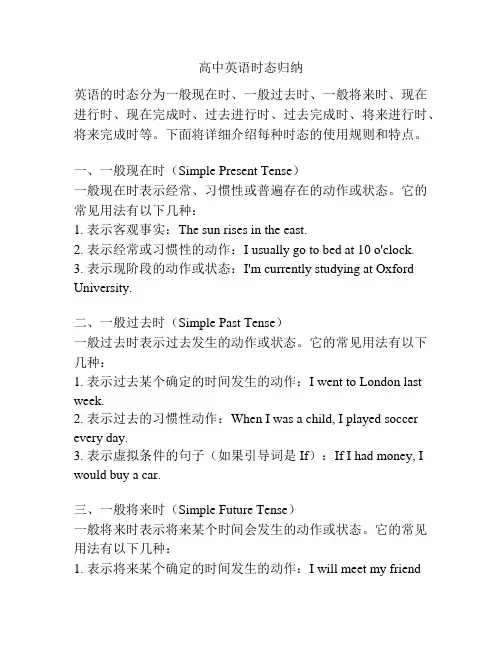
高中英语时态归纳英语的时态分为一般现在时、一般过去时、一般将来时、现在进行时、现在完成时、过去进行时、过去完成时、将来进行时、将来完成时等。
下面将详细介绍每种时态的使用规则和特点。
一、一般现在时(Simple Present Tense)一般现在时表示经常、习惯性或普遍存在的动作或状态。
它的常见用法有以下几种:1. 表示客观事实:The sun rises in the east.2. 表示经常或习惯性的动作:I usually go to bed at 10 o'clock.3. 表示现阶段的动作或状态:I'm currently studying at Oxford University.二、一般过去时(Simple Past Tense)一般过去时表示过去发生的动作或状态。
它的常见用法有以下几种:1. 表示过去某个确定的时间发生的动作:I went to London last week.2. 表示过去的习惯性动作:When I was a child, I played soccer every day.3. 表示虚拟条件的句子(如果引导词是If):If I had money, I would buy a car.三、一般将来时(Simple Future Tense)一般将来时表示将来某个时间会发生的动作或状态。
它的常见用法有以下几种:1. 表示将来某个确定的时间发生的动作:I will meet my friendtomorrow.2. 表示未来的预测、打算或意愿:I hope she will come to the concert.3. 表示对某个事件的推测或猜测:I think it will rain later.四、现在进行时(Present Continuous Tense)现在进行时表示现在正在进行的动作。
它的常见用法有以下几种:1. 表示现在进行的动作:I am studying English at the moment.2. 表示现阶段的习惯性动作:He is always complaining about his job.五、现在完成时(Present Perfect Tense)现在完成时表示过去发生的动作对现在造成的影响或状态,或者表示过去发生的动作具有的持续性。
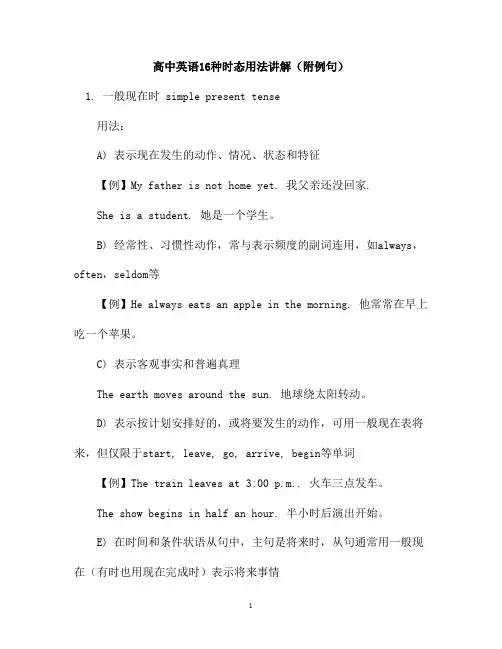
高中英语16种时态用法讲解(附例句)1. 一般现在时 simple present tense用法:A) 表示现在发生的动作、情况、状态和特征【例】My father is not home yet. 我父亲还没回家.She is a student. 她是一个学生。
B) 经常性、习惯性动作,常与表示频度的副词连用,如always,often,seldom等【例】He always eats an apple in the morning. 他常常在早上吃一个苹果。
C) 表示客观事实和普遍真理The earth moves around the sun. 地球绕太阳转动。
D) 表示按计划安排好的,或将要发生的动作,可用一般现在表将来,但仅限于start, leave, go, arrive, begin等单词【例】The train leaves at 3:00 p.m.. 火车三点发车。
The show begins in half an hour. 半小时后演出开始。
E) 在时间和条件状语从句中,主句是将来时,从句通常用一般现在(有时也用现在完成时)表示将来事情【例】I will go to bed when he comes back. 等他回来了我就去睡觉。
If you don't stop the yelling, I will leave right now. 如果你还继续大吼大叫的话,我现在就走。
2. 现在进行时 present progressive tense用法:A) 表示说话时正在进行的动作【例】They are having lunch. 他们在吃饭。
B) 表示现阶段正在进行的动作【例】We are looking for a new house. 我们现在在找新房子。
3. 现在完成时 present perfect tense用法:A) 表示动作到现在为止已经完成或刚刚完成【例】I have just finished my homework. 我刚刚才写完作业。
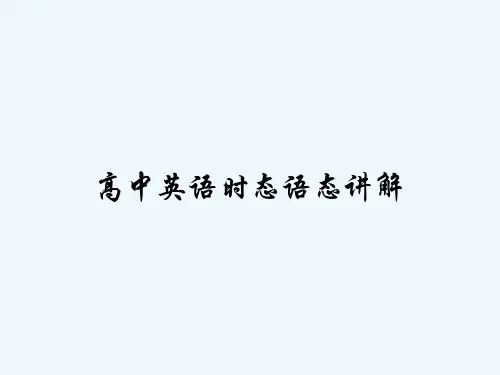
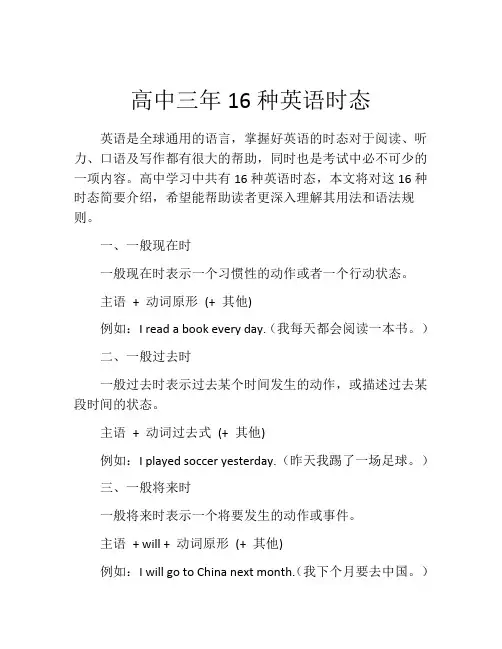
高中三年16种英语时态英语是全球通用的语言,掌握好英语的时态对于阅读、听力、口语及写作都有很大的帮助,同时也是考试中必不可少的一项内容。
高中学习中共有16种英语时态,本文将对这16种时态简要介绍,希望能帮助读者更深入理解其用法和语法规则。
一、一般现在时一般现在时表示一个习惯性的动作或者一个行动状态。
主语+ 动词原形(+ 其他)例如:I read a book every day.(我每天都会阅读一本书。
)二、一般过去时一般过去时表示过去某个时间发生的动作,或描述过去某段时间的状态。
主语+ 动词过去式(+ 其他)例如:I played soccer yesterday.(昨天我踢了一场足球。
)三、一般将来时一般将来时表示一个将要发生的动作或事件。
主语+ will + 动词原形(+ 其他)例如:I will go to China next month.(我下个月要去中国。
)四、现在进行时现在进行时表示正在进行的动作或者状态,也可以表示未来的计划。
主语+ am/is/are + 现在分词(+ 其他)例如:He is watching TV right now.(他正在看电视。
)五、过去进行时过去进行时表示过去某个时间正在进行的动作或状态,并且该动作是发生在过去某一时刻的。
主语+ was/were + 现在分词(+ 其他)例如:I was studying in the library at six p.m. yesterday.(昨天下午6点我正在图书馆学习。
)六、将来进行时将来进行时表示某个将来某个时间正在进行的动作或状态。
主语+ will be + 现在分词(+ 其他)例如:We will be having dinner at six p.m. tomorrow.(明天晚上六点我们正在吃饭。
)七、过去完成时过去完成时表示过去的某个时间之前已经完成的动作。
主语+ had + 过去分词(+ 其他)例如:We had finished our homework when our parents came back.(我们父母回来时我们已经完成了家庭作业。
高中英语十大时态一、一般现在时:1.结构:主语 + 动词原形(当主语是第三人称单数时,动词需加“s”或“es”);be 动词根据主语不同用“am/is/are”。
2.用法:●表示现在的情况、状态或特征。
例如:“He is a student.”(他是一个学生。
)●表示经常性、习惯性动作。
例如:“She often goes to school bybike.”(她经常骑自行车上学。
)●表示客观事实和普遍真理。
例如:“The earth moves around thesun.”(地球绕着太阳转。
)●表示按规定、计划或安排要发生的动作,常用于飞机、火车、轮船等定期定点运行的交通方式。
例如:“The next flight takes off at 8 o'clock tomorrow morning.”(下一趟航班明天早上8点起飞。
)二、现在进行时:1.结构:主语 + am/is/are + 动词的现在分词。
2.用法:●表示此时此刻正在发生的事情。
例如:“They are having a meetingnow.”(他们现在正在开会。
)●表示目前一段时间内一直在做的事情,但不一定此时此刻正在做。
例如:“I am learning French this semester.”(这学期我在学法语。
)●现在进行时可以表示将来的含义,通常是一些瞬间动词的进行时表将来,或者持续动词的进行时有将来的时间状语或语境时表将来。
例如:“I am leaving for Beijing tomorrow.”(我明天要去北京。
)三、现在完成时:1.结构:主语 + have/has + 动词的过去分词。
2.用法:●表示动作到现在为止已经完成或刚刚完成,强调对现在产生的影响。
例如:“I have finished my homework, so I can watch TV now.”(我已经完成作业了,所以现在可以看电视了。
高中英语时态总结在高中英语学习中,时态是一个至关重要的语法知识点。
掌握好时态,不仅能让我们更准确地表达自己的意思,还能帮助我们更好地理解英语文章。
下面就为大家详细总结一下高中英语中常见的时态。
一、一般现在时一般现在时表示经常发生的动作或存在的状态。
其构成是:主语+动词原形(当主语是第三人称单数时,动词要加“s”或“es”)。
例如:I go to school every day(我每天上学。
)He likes playing basketball(他喜欢打篮球。
)一般现在时的用法主要有以下几种:1、表示经常性或习惯性的动作,常与 often, always, usually, sometimes 等时间状语连用。
2、表示客观事实或普遍真理。
3、用于时间、条件、方式、让步等状语从句中,表示将来的动作。
二、一般过去时一般过去时表示过去某个时间发生的动作或存在的状态。
其构成是:主语+动词的过去式。
例如:I played football yesterday(我昨天踢足球了。
)一般过去时的用法:1、表示过去某个特定时间发生的动作或存在的状态,常与表示过去的时间状语连用,如 yesterday, last week, in 1998 等。
2、表示过去一段时间内经常或反复发生的动作。
三、一般将来时一般将来时表示将来要发生的动作或存在的状态。
其构成有多种形式,常见的有:“will +动词原形”和“be going to +动词原形”。
例如:I will go to Beijing next week(我下周将去北京。
)She is going to have a party tomorrow(她明天将举办一个派对。
)一般将来时的用法:1、表示将来要发生的动作或存在的状态。
2、表示将来的打算、计划或准备做某事。
四、现在进行时现在进行时表示正在进行的动作。
其构成是:主语+ be(am/is/are)+现在分词。
例如:I am reading a book now(我现在正在读一本书。
高中英语时态语法总结归纳英语时态是表示动作发生时间的一种语法形式,在高中英语学习中扮演着重要的角色。
正确使用时态可以使语言表达更加准确和流畅。
本文将对高中英语常用的时态进行总结归纳,以帮助学生更好地掌握时态的用法。
一、一般现在时 (Simple Present Tense)一般现在时用于表示经常性的动作、客观事实、真理、习惯和固定时间表等。
1. 结构:主语 + 动词原形(单数加s或es)+ 其他2. 示例:- He plays soccer every weekend.(他每个周末都踢足球。
)- Water boils at 100 degrees Celsius.(水在100摄氏度时沸腾。
)- I usually go to bed at 10 o'clock.(我通常十点钟上床睡觉。
)二、一般过去时 (Simple Past Tense)一般过去时用于表示过去某个时间发生的动作或状态。
1. 结构:主语 + 动词过去式(一般过去时动词过去式的变化规则多样)2. 示例:- They went to the park yesterday.(他们昨天去了公园。
)- She watched a movie last night.(她昨晚看电影了。
)- I played the guitar when I was young.(我年轻时弹吉他。
)三、一般将来时 (Simple Future Tense)一般将来时用于表示将来某个时间或情况下发生的动作或状态。
1. 结构:主语 + will/shall + 动词原形2. 示例:- We will study English tomorrow.(我们明天将学习英语。
)- He shall help you with your assignment.(他将帮助你完成作业。
)- They won't go to the party this weekend.(他们这个周末不会去参加派对。
动词16个时态一、一般现在时1.概念:表示经常发生的情况;有规律出现的情况;总是发生的;和事实真理。
2.时间状语:Always, usually, often, sometimes, every week (day, year, month…),once a week(day, year, month…),on Sundays(on Mondays …),3.基本结构:动词原形(如主语为第三人称单数,动词上要改为第三人称单数形式)4.否定形式:主语+ am/is/are + no t + 其他;此时态的谓语动词若为行为动词,则在其前加don't,如主语为第三人称单数,则用doesn't,同时还原行为动词。
5.一般疑问句:把be动词放于句首;用助动词do提问,如主语为第三人称单数,则用does,同时,还原行为动词。
6.例句:It seldom snows here.这里很少下雪。
He is always ready to help others.他总是乐于帮助别人。
Action speaks louder than words.事实胜于雄辩。
二、一般过去时1.概念:过去某个时间里发生的动作或状态;过去习惯性、经常性的动作、行为。
2.时间状语:ago, yesterday, the day before yesterday, last week, last(year, night, month…),in 1989,just now, at the age of 5,one day, long long ago, once upon a time, etc.3.基本结构:主语+ 动词的过去式或be的过去式+名词4.否定形式:主语+ was/were + not + 其他;在行为动词前加didn't,同时还原行为动词。
5.一般疑问句:was或were放于句首;用助动词do的过去式did 提问,同时还原行为动词。
高中英语语法八个时态归纳总结英语语法中的时态是指动词形态变化来表示不同的时间状态。
在英语语法中,共有八个时态,包括一般现在时、一般过去时、一般将来时、现在进行时、过去进行时、过去将来进行时、现在完成时和过去完成时。
这里将对这八个时态进行归纳总结,以帮助高中学生更好地理解和运用这些时态。
1. 一般现在时(Simple Present)一般现在时表示经常性、习惯性的动作或真理,也用于表示主语在现在的状态或职业。
例句:- I eat breakfast every morning.(我每天早上吃早餐。
)- The sun rises in the east.(太阳从东方升起。
)- She works as a teacher.(她是一名教师。
)2. 一般过去时(Simple Past)一般过去时表示过去某个时间发生或存在的动作或状态。
例句:- I studied English yesterday.(昨天我学习了英语。
)- They went to the beach last summer.(他们去年夏天去了海滩。
)- She lived in London for five years.(她在伦敦住了五年。
)3. 一般将来时(Simple Future)一般将来时表示将来某个时间要发生的动作或存在的状态。
例句:- I will go shopping tomorrow.(我明天要去购物。
)- They are going to visit their grandparents next month.(他们下个月要去看望他们的祖父母。
)- She is going to study abroad after graduation.(她毕业后打算出国留学。
)4. 现在进行时(Present Continuous)现在进行时表示现在正在进行的动作或状态。
例句:- I am reading a book right now.(我现在正在读一本书。